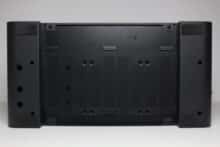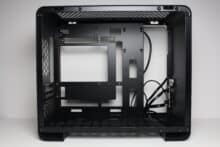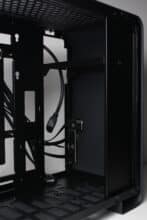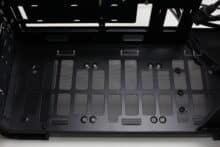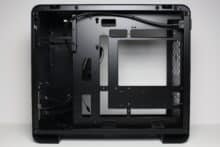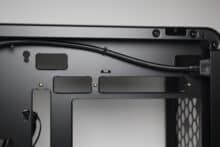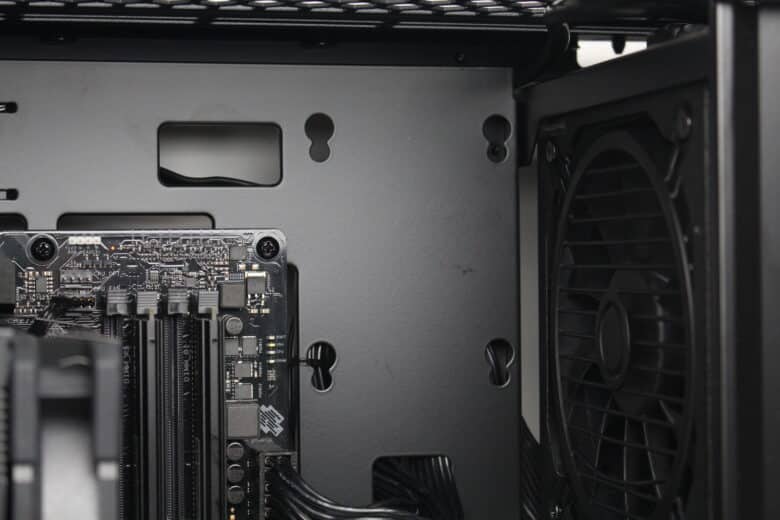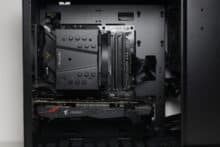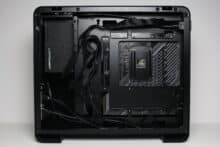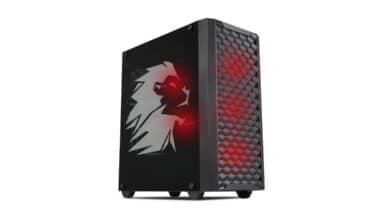
Jonsbo is a world-renowned Chinese manufacturer of computer components. In addition to ATX, µATX and ITX cases, the product portfolio now also includes CPU coolers and AiO water cooling systems. Jonsbo focuses primarily on a particularly extravagant design, which at the same time does not forget the intended use of the case. In January 2024, the manufacturer expanded its portfolio with the Jonsbo U4 Mini and Jonsbo U4 Mini Mesh, which we are testing today. If you want to buy the U4 Mini Mesh, you currently have to put € 64.90 * on the counter.
Technical details
| Model: | Jonsbo U4 Mini Mesh |
| Case type: | µATX |
| Dimensions: | 222 mm (W) x 385 mm (H) x 440 mm (D) |
| Weight: | 6.7 kg |
| Material: | Steel, plastic |
| Color: | Black |
| Front connections: | 1x USB-C 3.2 Gen2, 1x USB-A 3.0, 1x HD audio, 1x power switch |
| Drive bays: | 1x 3,5″ 1x 2,5″ |
| Expansion slots: | 5x horizontal |
| Form factors: | µATX, ITX |
| Ventilation: | Rear: 1x 120 mm Top: 3x 120 mm / 2x 140 mm Bottom: 3x 120 mm (2x 120 mm with HDD) |
| Radiators: | Rear: 1x 120 mm Top: 1x 240 mm / 1x 280 mm / 1x 360 mm (depending on the mounting position of the power supply unit) Bottom: 1x 360 mm (depending on the depth of the graphics card) |
| Max. CPU cooler height: | 165 mm |
| Max. Graphics card length: | 330 – 420 mm (depending on the length of the power supply unit) |
| Max. Power supply length: | 145 – 200 mm (depending on the length of the graphics card as well as the selected mounting position) |
| Space for cable management: | 30 mm |
| Price: | € 64.90 * |
| Special features: | Dust filter, cable management, |

Jonsbo U4 Mini Mesh Test: The scope of delivery
Jonsbo packs the U4 Mini Mesh in a plain brown cardboard box. Printed on it in black, we find some schematic drawings of the mini tower, a list of the technical data as well as an illustrated list of the most important features and a short description of the Jonsbo U4 Mini.
Inside the box, Jonsbo wraps the U4 Mini with two blocks of elastic foam and a thick plastic film. This combination should protect the mini tower well during transportation. The manufacturer places the accessories in a plastic bag. Included are all the necessary mounting screws in labeled bags, a nut for screwing in the spacers, 12 fan screws, some cable ties as well as assembly instructions and warranty information.
External impression
Immediately after unpacking, it is noticeable that the U4 Mini is neither particularly small nor particularly light for a mini tower. However, the latter in particular speaks for the solid material thickness. Visually, the Jonsbo U4 Mini looks very elegant and timeless. In particular, the use of a single, multi-bent sheet of steel for the front, lid, rear and feet is an interesting design that has not been seen so often before. But let’s start with the front.
As already mentioned, the front, the lid, the rear and the feet are made entirely of steel or form a coherent element that has been bent several times. Otherwise, the front is completely closed, but offers space for the I/O panel. This has been placed in the bottom right-hand corner and consists of two USB ports (1x USB-C 3.2 Gen2, 1x USB-A 3.0), an HD audio socket for headphones or microphone and a white backlit power button.
Compared to the front, the lid of the U4 Mini has a very airflow-friendly design. Here we find a large ventilation opening with mounting rails for three 120 mm or two 140 mm fans. Alternatively, correspondingly large radiators can of course also be accommodated here. The manufacturer has also positioned a magnetic mesh dust filter mat above the opening.
The case name already gives it away. The mesh version has no glass on the sides but solid steel side panels, in which a large number of small holes have been made, which ultimately result in a fine mesh structure. However, the side panels are not equipped with a dust filter and disassembly is also somewhat more complex. Unfortunately, the U4 does not use push pins to remove the side panels. Instead, the panels are hooked in at the top and screwed to the body from below. The mini tower must therefore always be laid on its side to remove the side panels.
After a quick look at the rear, it is immediately apparent that there is no opening for the power supply unit, only a socket for the power cable. Furthermore, five slots for expansion cards can be seen in the lower area, three of which are equipped with reusable covers. The panels or expansion cards are screwed in from the outside. Above this, there is space for a single 120 mm fan and the cut-out for the I/O panel of the power supply unit.
The underside continues where the lid left off. Here too, the design of the U4 Mini allows the installation of up to three 120 mm fans or a single 360 mm radiator. A mesh dust filter mat has also been placed here to protect against dust. Unlike in the lid, however, this does not have magnets and must be hooked in using steel tabs. The feet are part of the body and are made of bent steel. They also have rubber strips to protect the surface.
Interior impression
The interior of the Jonsbo U4 Mini is very spacious. The interior is divided into a large main chamber and a much smaller area behind the mainboard tray. The main chamber offers space for a standard-width µATX board, a long graphics card and an ATX power supply unit. The motherboard tray has numerous cable management openings, some of which are also intended for the new boards with rear connections (ASUS BTF, MSI Project Zero). Of course, the obligatory cut-out for the CPU cooler backplate is also a must.
As already suspected, the ATX power supply unit is mounted inside the U4 Mini with a frame behind the front panel. The fan must always face inwards due to the closed front. At the rear, we can see the free fan space and five expansion slots, which is rather unusual for a mini tower. There is also enough space above and below the motherboard tray for up to two 360 mm radiators.
At the rear of the motherboard tray, there is plenty of room to lay the cables with up to 30 millimeters of space. The well-placed cable management openings and eyelets for securing cable ties also help. The power supply frame has a modular design and can be attached in three different positions behind the front. All you have to do is loosen three screws. Jonsbo has pre-routed the power supply cable and placed it in the area of the power supply frame.
If you have a lot of data carriers, you might want to look at a different case. The Jonsbo U4 Mesh Mini only offers the option of mounting two data carriers in total. A single 2.5″ SSD can be attached to the rear of the mainboard tray. Another 3.5″ HDD can be screwed into the base, but then blocks a fan slot. In any case, the mounting is decoupled via rubber rings.
Processing
The workmanship of the Jonsbo U4 Mini Mesh is very good for a case in this price range. The fact that almost the entire case is made of steel means that the body looks very stable and solid, even without the side panels. The same applies to the side panels themselves. The use of a large steel plate, which makes the feet, front, lid and rear into one large unit thanks to the bends, also looks very stylish and has not been used so often before. Furthermore, the paintwork on the steel is largely flawless and we couldn’t find any sharp edges. To ensure that the paintwork remains as beautiful as it is, Jonsbo equips each screw with a soft washer to prevent the paint from cracking when it is screwed in. One disadvantage of the matt lacquer, however, is that it is very susceptible to fingerprints.
Jonsbo U4 Mini Mesh test: Installing the components
Now we come to the system installation for the Jonsbo U4 Mini test. As hardware, we use an AMD Ryzen 5 1400* on an ASUS TUF Gaming B550M-Plus* with 16GB Crucial Ballistix Sport LT gray DDR4-2666*. The Ryzen is cooled by an Alpenföhn Brocken 4* and is overclocked to 3.8 GHz (1.175 V). A Gigabyte AORUS GTX 1060 6GB is responsible for the image output. The power supply is provided by the fully modular LC-Power LC550 V2.31 Platinum*.
The installation of our test system in the U4 Mini proved to be a very simple process that neither led to frustration nor took a particularly long time. With the exception of a single stand-off, the spacers were all pre-installed and further accelerated the installation process. The generous amount of space was also helpful and had a positive effect on the cabling of the test system. The overall result makes a very good impression, so you could easily opt for the version with a side window.
In terms of hardware compatibility, the Jonsbo U4 Mini can easily keep up with the competition. There are 165 millimeters available for CPU coolers and the graphics card can also be at least 330 mm long or, with a shorter power supply unit, up to 420 millimeters. The latter can be up to 200 mm long before compatibility problems arise. Overall, however, there are strong dependencies between the graphics card, the power supply unit and its chosen mounting position. Unfortunately, Jonsbo does not provide clear information on all values and dependencies. Even the packaging contains more information on compatibility than the product description on the homepage.
However, the Jonsbo U4 Mini Mesh also offers a number of options for installing a water cooling system. Depending on the graphics card, up to two 360 mm radiators can be installed in the lid or base at the same time. However, the GPU must be a maximum of 2 slots thick and the power supply unit must be attached to the lowest mounting position or should generally be as short as possible.
Load test
Finally, we come to the temperatures achieved in the Jonsbo U4 Mini Mesh test. During the stress test, Prime95 and FurMark were run for 30 minutes at a room temperature of approx. 20 °C. In addition, the stress test was carried out in the factory configuration (without fan) and with a single rear fan with 50% PWM and 100% PWM speed.
Scenario |
Temperature |
| CPU: 50% PWM (900 rpm) GPU: 50% PWM (1650 rpm) without fan (factory setting |
CPU: 79.5 °C GPU: 73.5 °C |
| CPU: 50% PWM (900 rpm) GPU: 50% PWM (1650 rpm) Rear: 1x 120mm 50% PWM (950 rpm) |
CPU: 65.1 °C GPU: 64.8 °C |
| CPU: 50% PWM (900 rpm) GPU: 50% PWM (1650 rpm) Rear: 1x 120mm 100% PWM (1800 rpm) |
CPU: 60.7 °C GPU: 62.7 °C |
Even without any case fans, our test system does not reach highly critical temperatures in the worst-case scenario. However, the values achieved are not particularly good either. It is therefore all the more pleasing that even a slowly rotating fan in the rear has a very positive influence on the maximum temperatures. If you now install an AiO water cooling system in the lid and two to three fans in the base, you should also be able to cool more powerful hardware in the Jonsbo U4 Mini Mesh without any problems.
Jonsbo U4 Mini Mesh test: Conclusion
Now we come to the conclusion of this test. Overall, the Jonsbo U4 Mini leaves us with a good impression. The mini tower is very well made, looks very elegant thanks to its many curves and should therefore look good on any desk. It also offers plenty of space for both air and water cooling components and hardware in general. If desired, even particularly large graphics cards and a 360 mm radiator can fit inside at the same time. The cooling performance demonstrated by our test system was also impressive if you invest in fans in addition to the case.
A major disadvantage of the U4 Mini from our point of view, however, is its size. Because this case is not really that “mini”. The mini tower offers plenty of space for hardware, but at almost 38 liters it is also almost as big as a midi tower and therefore takes up a little more space on the desk. We also find the side panel disassembly too cumbersome and the use of a push-pin mechanism would have been desirable. Finally, we would recommend the manufacturer to update the website and the technical data on the U4 Mini. The information there is very patchy or not updated at all.
The purchase price of € 64.90 * set by Jonsbo does not seem excessive considering the features on offer. However, you should bear in mind that the Jonsbo U4 Mini is a rather large mini tower and comes without a fan ex works. Otherwise, the Jonsbo U4 Mini is an interesting case with an appealing look and a very good amount of space.
Jonsbo U4 Mini Mesh
Workmanship
Structure
Features
Cooling
Value for money
87/100
The Jonsbo U4 Mini Mesh offers a chic and elegant look, very good workmanship and plenty of space for hardware. However, this positive space offer leads to larger dimensions that are dangerously close to those of a midi tower.


















